Physical Address
304 North Cardinal St.
Dorchester Center, MA 02124
Physical Address
304 North Cardinal St.
Dorchester Center, MA 02124

Master tent selection by discovering which specific shelter matches your camping style—the wrong choice could ruin your entire outdoor adventure.
You’ve probably heard that one tent can handle every camping scenario, but that’s far from reality. Different adventures demand specific shelter solutions, and choosing wrong can turn your outdoor escape into an expensive mistake. Whether you’re planning a solo backpacking trip, a family weekend getaway, or tackling harsh winter conditions, each situation requires distinct features like weight, space, and weather resistance. Understanding these differences before you buy will save you money and guarantee comfortable nights under the stars.
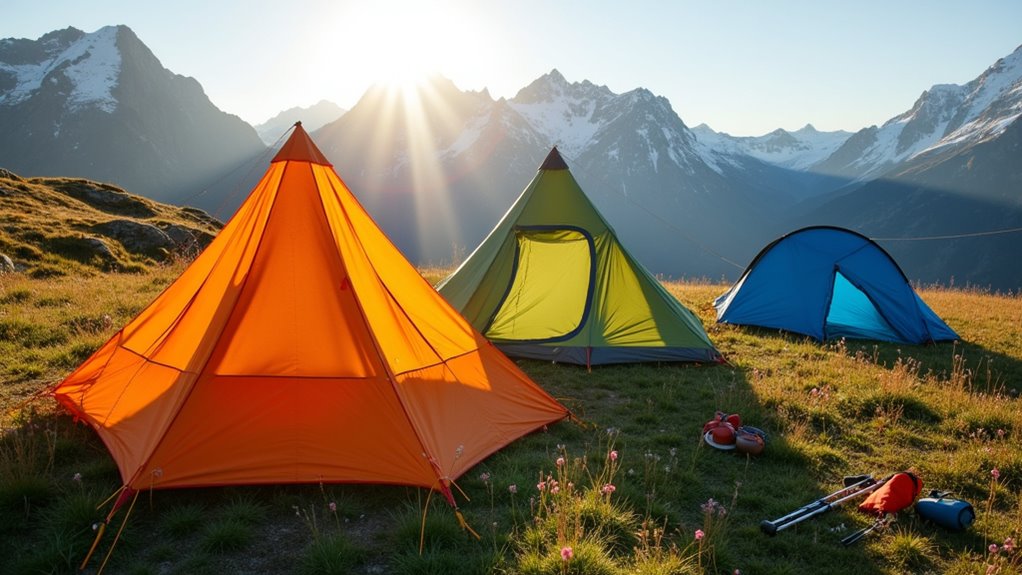
When you’re planning a multi-day hiking trip, every ounce in your pack matters. Backpacking tents prioritize weight savings without sacrificing essential protection from the elements.
Every ounce counts on multi-day treks, making lightweight shelter selection crucial for successful backpacking adventures.
You’ll find most backpacking tents weigh between 2-4 pounds and pack down to the size of a sleeping bag. Look for single-wall designs or ultralight double-wall options with aluminum poles and ripstop nylon materials. These features reduce weight while maintaining durability.
Don’t overspend on premium ultralight models unless you’re serious about shaving every ounce. Mid-range options from reputable brands offer excellent weight-to-durability ratios at reasonable prices.
Consider freestanding designs if you’ll camp on rocky terrain where stakes won’t penetrate easily. Non-freestanding tents require guylines but typically weigh less and cost less than freestanding alternatives.
Just like avoiding common mistakes when purchasing recreational vehicles, researching tent features thoroughly before buying ensures you get the best value for your camping needs.
While backpacking tents focus on minimal weight, family camping tents prioritize space and comfort for groups of three or more people. You’ll find these tents much roomier, with higher ceilings that let you move around without constantly hunching over.
When shopping for family tents, consider these key features:
Family tents typically cost more than solo options, but you’re getting markedly more living space. They’re heavier and bulkier, so they’re best for car camping where you won’t carry them far.
Don’t forget to pack water purification systems alongside your family tent, as clean drinking water becomes even more critical when camping with larger groups for extended periods.
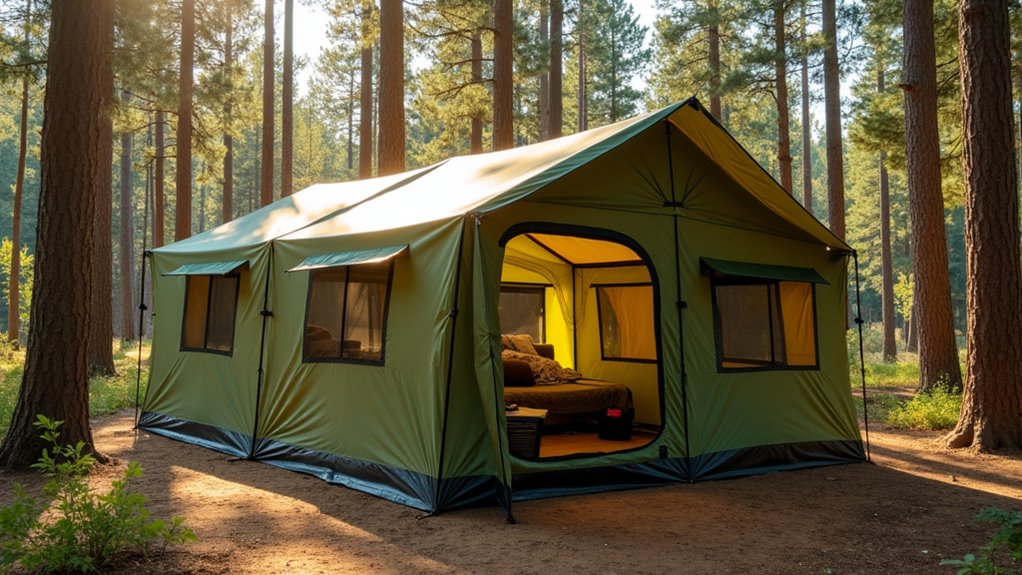
If you want even more space than family tents offer, cabin tents represent the ultimate in camping luxury. You can actually stand upright and move around comfortably inside these spacious shelters. They’re designed with near-vertical walls that maximize every square foot of floor space.
Most cabin tents accommodate 6-12 people with separate rooms or dividers for privacy. You’ll find convenient features like gear lofts, electrical cord access, and multiple windows for ventilation.
The generous headroom means you can change clothes without crouching.
However, they’re heavier and bulkier than other tent types, requiring more setup time. They also cost more upfront.
If you’re car camping with a large group and prioritize comfort over portability, cabin tents deliver excellent value for extended camping trips. Cabin tents are one of six essential types that every camper should be familiar with when choosing the right shelter for their outdoor adventures.
Since dome tents use flexible poles that bend into curved arcs, they create one of the most wind-resistant shapes you can pitch in the wilderness. You’ll find these tents handle storms, snow loads, and gusty conditions better than most alternatives without breaking your budget.
Dome tents’ curved pole design creates superior wind resistance, making them ideal for harsh wilderness conditions without the premium price tag.
Dome tents offer three key advantages for weather protection:
You can set up most dome tents quickly, even in challenging weather. They’re lighter than cabin tents but still provide decent interior space.
For year-round camping on a budget, dome tents deliver reliable performance when conditions get rough. After your camping season ends, proper winter storage ensures your dome tent stays in excellent condition for future adventures.
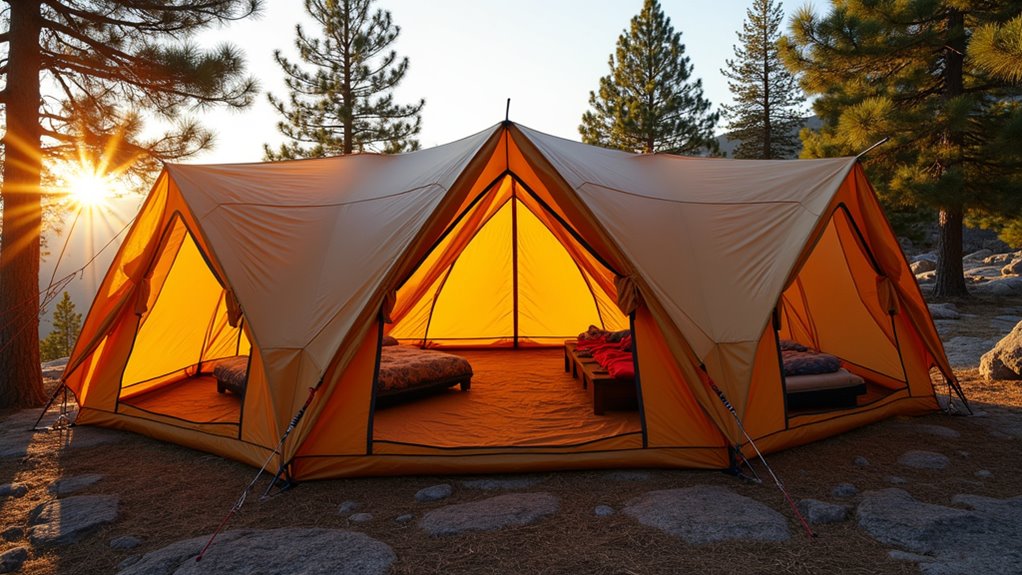
When you need maximum living space without stepping up to a full cabin tent, tunnel tents give you the best balance of room and portability. These elongated shelters use multiple poles to create a tunnel-like structure that maximizes floor space and headroom.
You’ll find tunnel tents perfect for family camping or extended trips where comfort matters. The design creates separate sleeping and living areas, letting you store gear without cramping your sleeping space.
Most models accommodate 4-6 people comfortably while remaining lightweight enough for car camping.
Setup requires staking guy-lines for stability, so you’ll need adequate space and decent weather conditions. Budget-friendly options start around $150, making tunnel tents an affordable upgrade from basic dome designs when you’re ready for more room.
For extreme conditions like glacier climbing, specialized tunnel tents offer the durability and weather protection needed for challenging mountain environments.
For campers who prioritize speed over space, pop-up tents deliver unmatched convenience with their instant-setup design. You’ll appreciate how these spring-loaded shelters unfold in seconds, eliminating the frustration of threading poles and deciphering instruction manuals during bad weather or dim lighting conditions.
Pop-up tents work best for:
However, you’ll sacrifice interior space and wind resistance compared to traditional tents. These lightweight options typically accommodate 1-3 people comfortably.
While they won’t handle extreme weather, pop-up tents excel for casual camping adventures where convenience trumps performance requirements. If you need more space and amenities for extended trips, consider upgrading to self-contained camping trailers that offer greater comfort and weather protection.
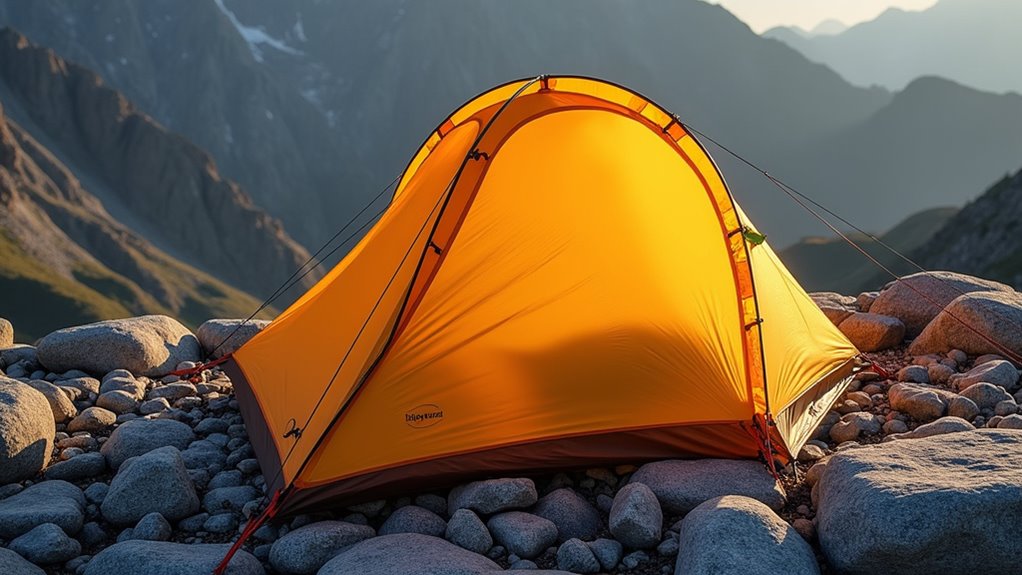
While pop-up tents prioritize convenience, ultralight tents focus on shedding every unnecessary ounce for backpackers who’ll carry their shelter for miles. These stripped-down shelters typically weigh under three pounds and use premium materials like silnylon or Dyneema fabric.
Every ounce counts when you’re carrying your shelter for miles—ultralight tents strip away excess weight using premium materials like Dyneema.
You’ll sacrifice some comfort for weight savings. Most ultralight tents have minimal interior space, single-wall construction, and require trekking poles instead of traditional tent poles. They’re perfect if you’re hiking long distances where every ounce matters.
Expect to pay more – quality ultralight tents cost $200-500. However, you’ll appreciate the reduced pack weight on steep climbs.
Popular options include the Big Agnes Tiger Wall and REI Quarter Dome SL. Consider your priorities: if weight trumps space and budget, ultralight tents deliver unmatched portability.
Understanding the various types of camping tents available helps you make the best choice for your specific outdoor adventures and camping style.
Ultralight tents excel in fair weather, but you’ll need serious protection when facing snow, ice, and howling winds. Four-season tents are built like fortresses, designed to handle nature’s worst tantrums without breaking your budget or your back.
These heavy-duty shelters feature reinforced poles, typically aluminum, and robust fabrics that won’t tear under pressure. You’ll find steeper wall angles that shed snow effectively, plus vestibules for gear storage when you can’t leave anything outside.
Key features to look for:
Expect to pay more upfront, but you’ll appreciate the investment when you’re warm and dry inside while storms rage outside. Proper maintenance includes keeping your tent spotlessly clean after each expedition to extend its lifespan and ensure peak performance.
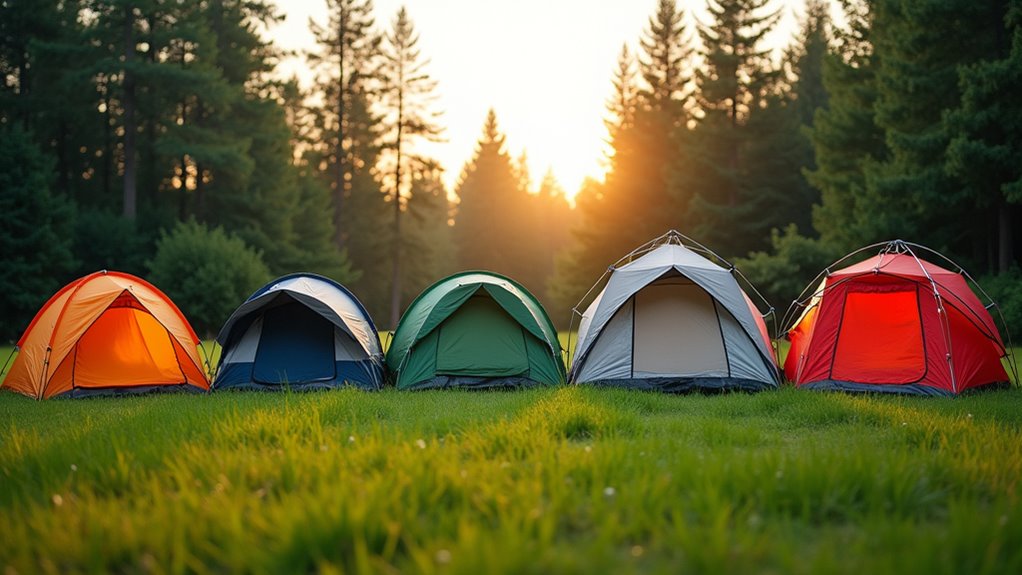
Once you’ve narrowed down your tent type, the real challenge begins: finding the perfect size and features that match your camping style without emptying your wallet.
Don’t fall for marketing tricks claiming “sleeps four” when it barely fits two adults comfortably. Add one person to manufacturer ratings for realistic space. Consider your gear storage needs—you’ll want room for backpacks and equipment.
Manufacturer tent capacity ratings are notoriously optimistic—always size up by one person for comfortable camping with gear storage space.
Essential features worth paying for include quality zippers, waterproof ratings above 1,500mm, and color-coded poles for easy setup. Skip expensive extras like built-in LED lights or multiple vestibules unless you’ll actually use them.
Measure your current sleeping arrangements at home. If you’re cramped on a queen mattress, you’ll hate sharing a two-person tent.
Remember that selecting the right tent is one of the most crucial tent camping tips that will determine your overall outdoor experience and comfort level.
You’ve explored every excellent option, from budget-friendly backpacking basics to spacious family favorites. Don’t drain your dollars on unnecessary features – pick practically based on your planned adventures. Whether you’re seeking sturdy storm protection or convenient quick-setup solutions, there’s a tent that’ll fit your finances and fulfill your camping dreams. Remember, the right tent transforms tough trips into treasured memories, so choose carefully and camp confidently on your next outdoor adventure.